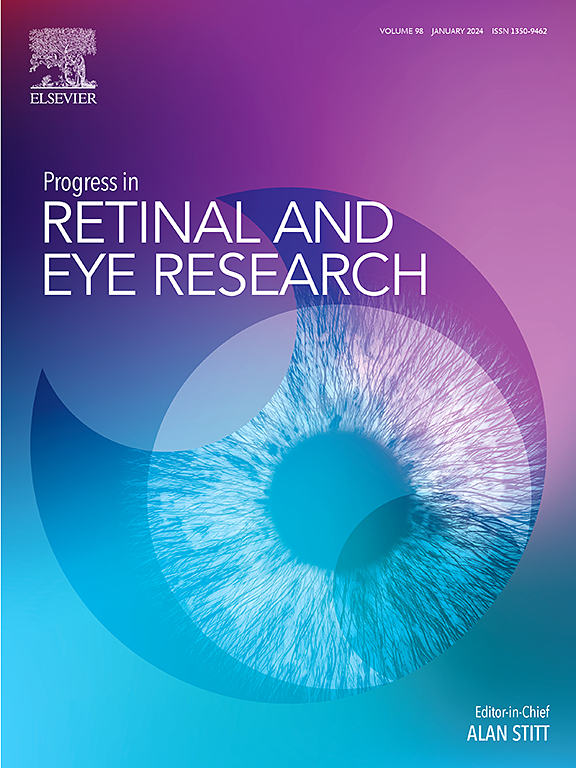眼科:当前的概念和证据。
IF 14.7
1区 医学
Q1 OPHTHALMOLOGY
引用次数: 0
摘要
眼睛为一般健康以及全身性疾病的发病机制和发展提供了新的见解。在过去的十年中,越来越多的证据表明,眼睛的结构和功能反映了多种全身健康状况,特别是在心血管疾病、神经退行性疾病和肾脏损伤中。这导致了眼组学领域的兴起-应用眼科生物标志物来了解机制,检测和预测疾病。这一领域的发展被三个主要进展所加速:1)高分辨率和非侵入性眼科成像(“硬件”)的可用性和广泛的临床采用;2)大型研究的可用性(“大数据”);3)新型分析方法的发展,包括人工智能(AI)(“软件”)。眼组学提供了一个机会来加强我们对眼睛和身体之间相互作用的理解,同时支持创新诊断、预后和治疗工具的发展。人工智能的发展,加上将眼部成像数据与系统健康数据联系起来的大规模链接数据集,进一步加速了这些进步。眼组学还可以检测、筛选、诊断和监测许多全身健康状况。此外,人工智能的经济学可以预测全身性疾病的风险,实现风险分层,开辟新的预防途径或个性化风险预测和预防,促进个性化医疗。在这篇综述中,我们总结了目前在经济学领域的概念和证据,强调了已经取得的进展,仍然存在的挑战,以及未来研究的机会。本文章由计算机程序翻译,如有差异,请以英文原文为准。
Oculomics: Current concepts and evidence
The eye provides novel insights into general health, as well as pathogenesis and development of systemic diseases. In the past decade, growing evidence has demonstrated that the eye's structure and function mirror multiple systemic health conditions, especially in cardiovascular diseases, neurodegenerative disorders, and kidney impairments. This has given rise to the field of oculomics-the application of ophthalmic biomarkers to understand mechanisms, detect and predict disease. The development of this field has been accelerated by three major advances: 1) the availability and widespread clinical adoption of high-resolution and non-invasive ophthalmic imaging (“hardware”); 2) the availability of large studies to interrogate associations (“big data”); 3) the development of novel analytical methods, including artificial intelligence (AI) (“software”). Oculomics offers an opportunity to enhance our understanding of the interplay between the eye and the body, while supporting development of innovative diagnostic, prognostic, and therapeutic tools. These advances have been further accelerated by developments in AI, coupled with large-scale linkage datasets linking ocular imaging data with systemic health data. Oculomics also enables the detection, screening, diagnosis, and monitoring of many systemic health conditions. Furthermore, oculomics with AI allows prediction of the risk of systemic diseases, enabling risk stratification, opening up new avenues for prevention or individualized risk prediction and prevention, facilitating personalized medicine. In this review, we summarise current concepts and evidence in the field of oculomics, highlighting the progress that has been made, remaining challenges, and the opportunities for future research.
求助全文
通过发布文献求助,成功后即可免费获取论文全文。
去求助
来源期刊
CiteScore
34.10
自引率
5.10%
发文量
78
期刊介绍:
Progress in Retinal and Eye Research is a Reviews-only journal. By invitation, leading experts write on basic and clinical aspects of the eye in a style appealing to molecular biologists, neuroscientists and physiologists, as well as to vision researchers and ophthalmologists.
The journal covers all aspects of eye research, including topics pertaining to the retina and pigment epithelial layer, cornea, tears, lacrimal glands, aqueous humour, iris, ciliary body, trabeculum, lens, vitreous humour and diseases such as dry-eye, inflammation, keratoconus, corneal dystrophy, glaucoma and cataract.

 求助内容:
求助内容: 应助结果提醒方式:
应助结果提醒方式:


